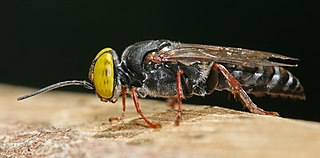
The Crabronidae are a large paraphyletic group of wasps, including nearly all of the species formerly comprising the now-defunct superfamily Sphecoidea. It collectively includes well over 200 genera, containing well over 9000 species. Crabronids were originally a part of Sphecidae, but the latter name is now restricted to a separate family based on what was once the subfamily Sphecinae. Several of the subfamilies of Crabronidae are often treated as families in their own right, as is true of the most recent phylogenies.

The organ pipe mud dauber is a predatory wasp in the family Crabronidae. They are fairly large wasps, ranging from 3.9–5.1 cm, and have been recorded to fly from May to September. Female and male are similar in colour, a shiny black with pale yellow to white hind hindtarsomere. The organ pipe mud dauber feeds mainly on three genera of spider: Neoscona, Araneus, and Eustala. Melittobia, a parasitoid wasp, is a common ectoparasite of T. politum prepupae. Other sources of parasitism include the Bombyliid fly Anthrax, Chrysidid wasps, and various species of scavenger flies (Miltogramminae). The tufted titmouse is a known predator of T. politum, and may feed on them more commonly than previously thought as the holes made by the titmouse are similar in shape and size to those made by T. politum leaving the nest after pupation.

The subfamily Crabroninae(digger wasps) is the most diverse group in the wasp family Crabronidae, containing over 110 genera and 4,800 described species. The subfamily consists of solitary, predatory wasps. The adult females of many groups dig tunnels in the ground for nesting, but others use different techniques, including the construction of tube-like mud nests.
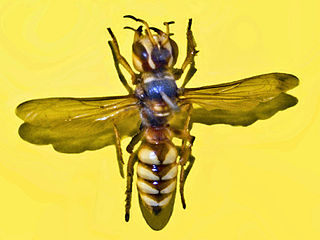
Cerceris tuberculata is a species of wasp in the family Crabronidae.

Chrysidea pumila is a species of cuckoo wasps belonging to the subfamily Chrysidinae. Some authors consider this species as a synonym of Trichrysis pumilionis Linsenmaier, 1987.

Pseudomalus auratus is a species of cuckoo wasps.

Larra anathema is a species of parasitoid wasps belonging to the family Crabronidae. It is the type species of the genus Larra.
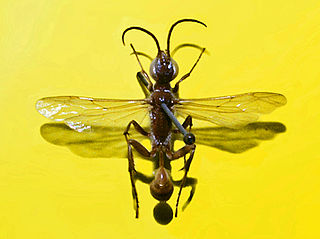
Chalybion flebile is a species of mud dauber wasps belonging to the family Sphecidae.

Stizus is a genus of sand wasps belonging to the family Crabronidae. There are over 100 species.

Stizus fasciatus is a species of sand wasps belonging to the family Crabronidae.
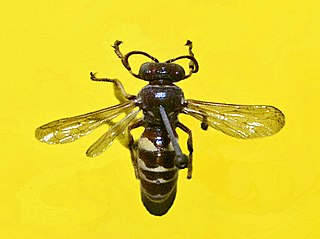
Bembecinus tridens is a species of sand wasps belonging to the family Crabronidae.

Crabro cribrarius, common name slender bodied digger wasp, is a species of wasp of the family Crabronidae.
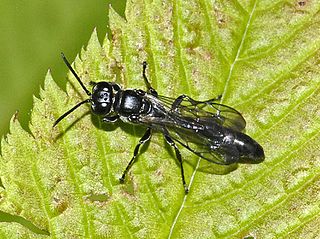
Trypoxylon is a genus of wasps in the family Crabronidae. All Trypoxylon species that have been studied so far are active hunters of spiders, which they paralyse with a venomous sting, to provide as food to their developing larvae. Depending on the species, they will either construct their own nest from mud or find cavities that already exist. These cavities can range from keyholes to nail holes to previously abandoned nests, and are generally sealed with mud to create cells for their larvae.

Tachytes etruscus is a predatory, solitary wasp belonging to the family Crabronidae. The species was first described by Pietro Rossi in 1790.

Argogorytes mystaceus is a species of solitary wasp in the family Crabronidae.
Trypoxylon frigidum is a species of square-headed wasp in the family Crabronidae. It is found in North America.

Trypoxylon collinum is a species of square-headed wasp in the family Crabronidae. It is found in North America. It nests inside hollow tubes.
Trypoxylon lactitarse is a species of square-headed wasp in the family Crabronidae. It is found in Central America, North America, and South America. These are fairly common harmless black wasps that build muddy elongate nests on the external walls of houses and low-story apartments. Their characteristic nests resemble pan-flutes in shape, and are provisioned with spiders captured and paralysed by the mother wasp. It lays an egg within each elongate nest cell amongst the invalid spiders, from which a larva will hatch and slowly consume all spiders as food. This species apparently undergoes four larval moults until completing their development as pupae inside a black cocoon.
Trypoxylon clavatum is a species of square-headed wasp in the family Crabronidae. It is found in North America.

Trichrysis cyanea is a species of cuckoo wasps, insects in the family Chrysididae.
















